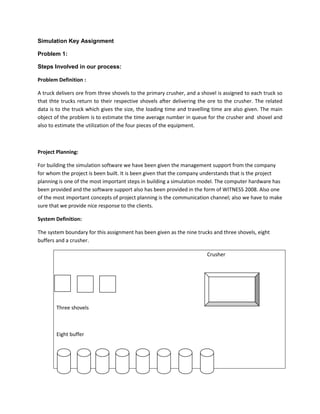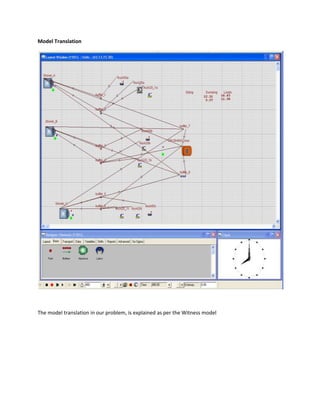Simulation Project
- 1. Simulation Key Assignment<br />Problem 1:<br />Steps Involved in our process:<br />Problem Definition : <br />A truck delivers ore from three shovels to the primary crusher, and a shovel is assigned to each truck so that thte trucks return to their respective shovels after delivering the ore to the crusher. The related data is to the truck which gives the size, the loading time and travelling time are also given. The main object of the problem is to estimate the time average number in queue for the crusher and shovel and also to estimate the utilization of the four pieces of the equipment.<br />Project Planning:<br />For building the simulation software we have been given the management support from the company for whom the project is been built. It is been given that the company understands that is the project planning is one of the most important steps in building a simulation model. The computer hardware has been provided and the software support also has been provided in the form of WITNESS 2008. Also one of the most important concepts of project planning is the communication channel; also we have to make sure that we provide nice response to the clients.<br />System Definition:<br />409575112966500The system boundary for this assignment has been given as the nine trucks and three shovels, eight buffers and a crusher. <br />Crusher <br />40576502108200015049502870200096202528702000<br /> <br />Three shovels<br />Eight buffer<br />4762501181100039528751181100034290001181100029051251181100023907751181100018954751181100014097001181100096202511811000<br />4438650184150039528751841500342900018415002905125184150023907751841500189547518415001390650184150093345018415004762503746500Nine trucks<br /> Conceptual Model Formulation:<br />To develop the model we will have to first develop a preliminary model in a graphical manner with the suitable pseudo-code, which will help us in determining components, variables and interactions. With this preliminary model, we can make and develop other alternative models. We must take care to see that the large systems should be broken down to reduce the complexity of the model.<br />Preliminary Experimental Design:<br />The systemâs performance has to be selected. Various factors will be analyzed and will be varied, but since the system here is very small, so wonât have so much variability. The main favorable thing about this step is that we can plan the model with the desired data most effectively and efficiently. <br />Input data preparation: <br />The input data given to us is elucidated in the table mentioned below:<br />Truck sizeloadtravel dumpreturn<br /> tons<br /> 20 Exp distn with mean 5 const 2.5Exp distn with mean 2 const 1.5<br /> 50 Exp distn with mean 10const 3exp distn with mean 4 const 2<br />Model Translation<br />The model translation in our problem, is explained as per the Witness model <br />Verifiaction and Validation:<br />We see that shovel A,B,Care almost equal busy and that the crusher is busy for 87.01%. Also the model never stops so we can say that the model is proper.<br />Final Experimentation Design:<br />From our design experimentation using Witness we can infer that the analysis can be applied to the results. The success of Witness can be seen answering the questions asked in the model. This model shows makes our model correct.<br />Analysis and Interpretation:<br /> In this phase the simulation outputs are compared to various cases. But since the system is very small the chance of making changes to study will make the variations in the case very small.<br />Documentation and Implementation:<br />The project is said to be complete only when our results have been well understood, and accepted.<br />If our documentation is not proper it will be an appropriate model.<br />




